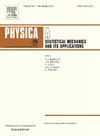On the impacts of dedicated lanes for CAVs in mixed traffic: Evaluation using a modified cell transmission model
IF 2.8
3区 物理与天体物理
Q2 PHYSICS, MULTIDISCIPLINARY
Physica A: Statistical Mechanics and its Applications
Pub Date : 2025-02-06
DOI:10.1016/j.physa.2025.130418
引用次数: 0
Abstract
Dedicated lane (DL) for connected and autonomous vehicles (CAVs) is a potential solution to manage mixed traffic flow of CAVs and human-driven vehicles (HVs) in the near future. In this paper, we propose a modified cell transmission model (CTM) to evaluate the performance and efficacy of CAV DLs under different scenarios in mixed traffic environments. We integrate the mixed traffic flow fundamental diagram and logit model to calculate through and lane-change flow. The model specifically considers the capacity drop phenomena and driving rules on DLs. Numerical experiments are conducted on a three-lane circular road to analyze the impacts of number, length, and position of DLs under varying CAV penetration rates and traffic demands on the mixed traffic flow. The experimental results suggest that the greatest benefits are achieved when DLs are implemented under conditions of high traffic demand and low CAV penetration rates. The effectiveness of setting different numbers of DLs varies under different demand levels and penetration rates. In scenarios where lanes have different speed limits, adjusting the horizontal position of the DLs yields more significant effects; setting DLs sequentially from the edge and in adjacent lanes — whether on high-speed or low-speed lanes — is an effective choice. Subsequently, based on the overall utility of the road segment, the conditions for implementing partial DLs are further analyzed. The findings provide insights for maximizing the advantages of CAVs, enhancing the orderliness and stability of mixed traffic flow, and offer a theoretical basis for future CAV DL deployment and traffic management.
求助全文
约1分钟内获得全文
求助全文
来源期刊
CiteScore
7.20
自引率
9.10%
发文量
852
审稿时长
6.6 months
期刊介绍:
Physica A: Statistical Mechanics and its Applications
Recognized by the European Physical Society
Physica A publishes research in the field of statistical mechanics and its applications.
Statistical mechanics sets out to explain the behaviour of macroscopic systems by studying the statistical properties of their microscopic constituents.
Applications of the techniques of statistical mechanics are widespread, and include: applications to physical systems such as solids, liquids and gases; applications to chemical and biological systems (colloids, interfaces, complex fluids, polymers and biopolymers, cell physics); and other interdisciplinary applications to for instance biological, economical and sociological systems.

 求助内容:
求助内容: 应助结果提醒方式:
应助结果提醒方式:


